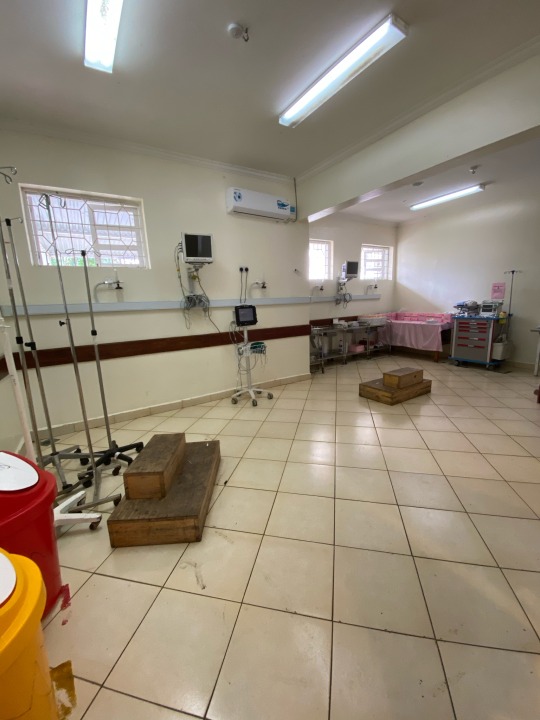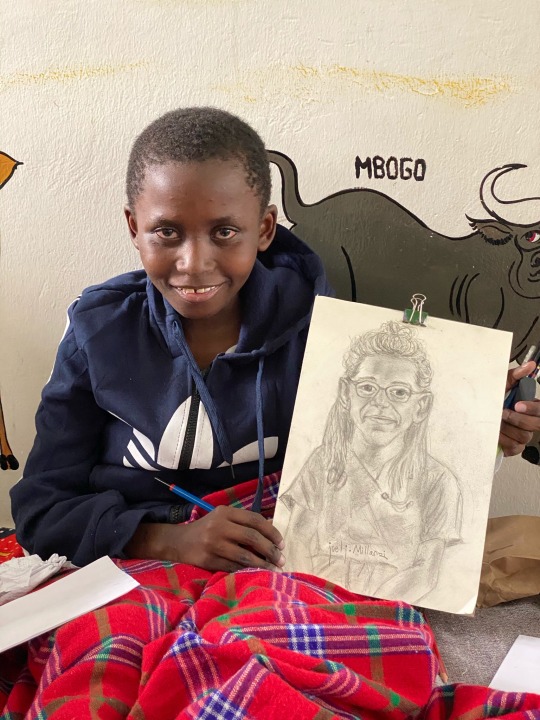#after 170 hours; 7 days! my sketch is completed
Text
911
Week Two: 🚑
My heart needed a break from dying babies and feeling helpless, so I decided to spend my second week in the emergency department, hoping this is somewhere I could actually be of use. Unfortunately, I think my heart is heavier still after this week. On Monday morning, within minutes of stepping into the ward, I passed a hallway with a single gurney that held a small body, covered completely by a Maasai cloth drape. The paper laying atop the body read simply:
Age: 5
Gender: Female
Cause of Death: Unknown.
I stepped into the bathroom to catch my breath.
Our first patient, a 60-ish year old male, presented with a blood-filled mouth, left sided hypertonia, right sided facial drop + hyperactive hand movement. It costs 12,000 TSH to be seen by a doctor. His coworkers, who transported him to the ER, had to pay before he was allowed in the doors. Point of care testing for HIV was immediately preformed: negative. They don’t have the ability to order a drug/tox screen. The next step, after collecting a limited history, was a head CT, but that costs 250,000 TSH (which is approximately three months salary for the patient). For hours, as the patient continues to respond minimally, the coworkers call friends and family members to see if they can put together enough money to pay for the CT scan. They finally conclude that it won’t be possible, but they can pay the 12,000 TSH it costs to be admitted for the week for observation. (Trauma Bay pictured below)

A plethora of unique patients roll in, one after another after another after another. None of them speak any English, making clinical investigation and management a slow and tedious process. Each patient seems more critical than the next. Unlike the United States, where most patients present when an affliction becomes noticeable and/or bothersome, patients here wait to present to the hospital until it’s the only choice they have. This is especially true in the urgent care setting, where I saw, most notably, esophageal cancer so advanced the patient could barely swallow water and Non-Hodgkins lymphoma present with a mediastinal tumor the size of a small grapefruit that had been symptomatic for over a year. The MD that I was with let out a big sigh and said, “I hate giving bad news like this because in all likelihood, she won’t be able to pay for treatment.” Making this a terminal diagnosis, even though it wouldn’t need to be in the States. This hit me like a lead pipe against the head: I would almost certainly be dead if I lived here at the time of my cancer diagnosis.
Thursday met us with perhaps the most gut wrenching patient yet. An 8 year old boy was brought in by his family, who discovered him convulsing when they went to wake him that morning. No real history could be ascertained. He appears dramatically malnourished. Pupils constricted but reactive to light, tachycardic with a mild fever noted, other vital signs normal. No nuchal rigidity. Blood sugar within normal limits. GCS of 7 (No verbal response, no eye opening, withdraws from pain). Diazepam 10mg IV push given. During the next few episodes of convulsions, his heart rate spikes to the 170s. No fluid has been initiated yet. It’s been at least 20 minutes now. Hospital personnel have started to sit down to chart, go check on other patients, take their break, etc. I’m frozen on the spot beside this child feeling sick to my stomach and helpless. It’s not my place, here, to interject my medical opinion. But, as I watch him start to seize again and his heart rate rise, I step out into the hallway and ask one of the intern doctors, “Should we start some fluid to decrease this heart rate?”. She responds, “Oh that’s a good idea!”, and returns a few minutes later with the equivalent of lactated ringers. When she returns to check on him 20-30 minutes later, he’s still convulsing. She decides to try Phenobarbital 100mg IV. Then another hour later, another 100mg IV. No change. They decide to admit him to the pediatric unit because they don’t know what else to do. Another patient comes into the trauma bay, so he’s taken off the monitor and left to await transport. Before he leaves the ED, I shine a light into his eyes and my fear is confirmed: pupils are pinpoint and fixed. Brain dead.

It’s infuriating, leaving the well-oiled machine that is emergency medicine in the States, and arriving to this. When a true emergency rolls through the doors at home, 15 people jump in, all with specific roles to fulfill. Everyone knows how dyer the situation is and we check every. single. thing. off the list of interventions to try before anyone even thinks of taking their eyes off the patient. We try and try and try and we don’t rest until the patient starts to improve or we know we’ve tried everything that we possibly can. Here, it seems as though death, even for children, is viewed as inevitable and it’s really not in our control whether it happens or doesn’t. I’m not sure if it’s because they don’t have the supplies or the equipment. I’m not sure if, because people seem to be dying left and right, they just don’t have the energy to fight what seems like another losing battle. I don’t know. What I do know is that this week I really struggled to understand the care and empathize with the providers here. Our program, and the general mission of global healthcare education, tells us that we’re supposed to be here to learn, not to teach (or preach), but I’ve never felt as hopeless and powerless as I did in that room, watching that little boy lose brain function by the second, minute, hour. It was a million times worse because I know other outcomes were possible.
And still, more patients roll in. Here’s my favorite from the day: a 40-something year old male in a motorcycle crash. Open comminuted femur fracture. He sat on a stretcher for HOURS in the ED awaiting surgery.


By the time Friday afternoon rolled around, I was mentally and emotionally exhausted and I needed a break. One very special kid, we’ll call him “J”, (he’s given me permission to post the following pictures) has been on the pediatric inpatient unit for the entire time that we’ve been here. Three weeks, stuck in bed with nothing to do except listen to the sick and crying younger children in neighboring beds. One of my classmates, Cienna, bonded with him from day one and discovered that he loves drawing. She brought him pencils and a sketch book and he asked to draw her earlier in the week. I happily volunteered to be next in line so by the time Friday afternoon rolled around, it was the most welcome way to recharge for me and, I hope, for J too. I sat in front of him making funny faces and getting to know him while he worked.

He told me when he grows up he wants to be an artist, and maybe a doctor too. His favorite subject in school, besides art, is science. He loves it when it rains and he has three older brothers. His mom died when he was younger, so it’s his aunt and uncle who sit vigil beside him, day in and day out. His uncle, John, a professional artist, calls J his star student. I know I’ll cherish my “J original” for as long as I live.


If you’re in the market for a beautiful art piece, John ships worldwide. I’ll attach his business card. Their art is such a ray of sunshine in this sometimes cruel world. Thank you both ❤️

0 notes